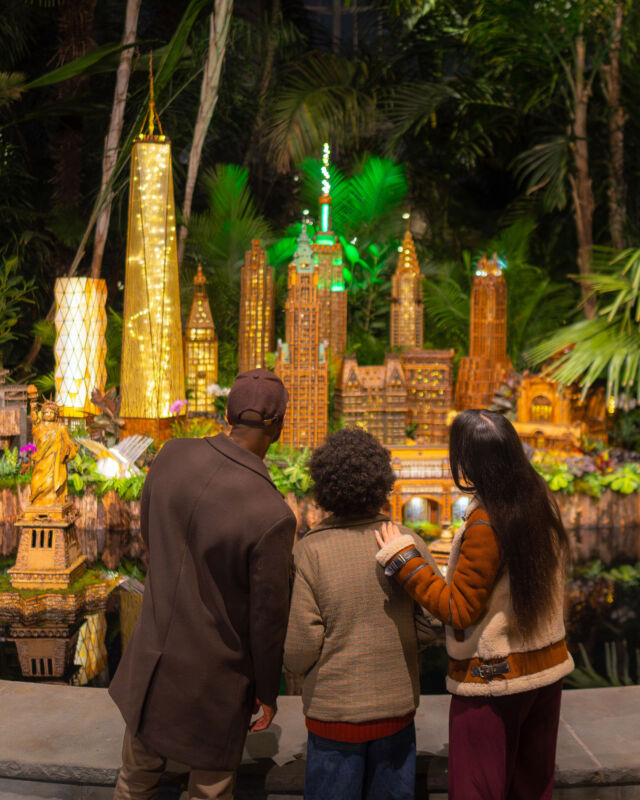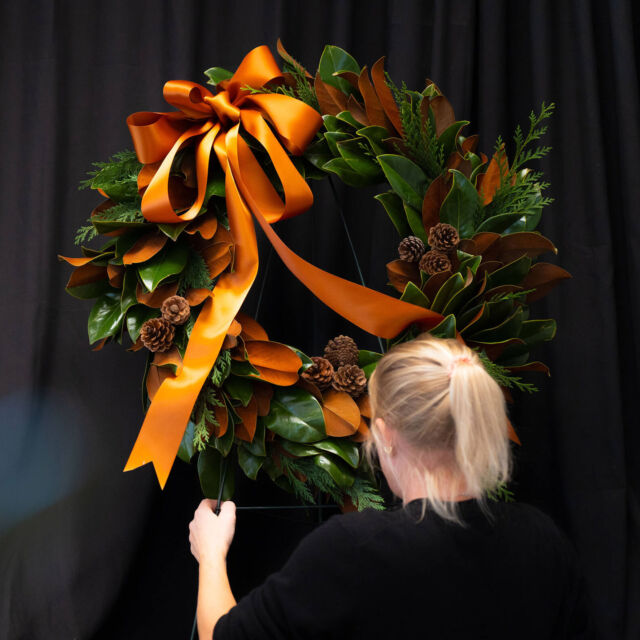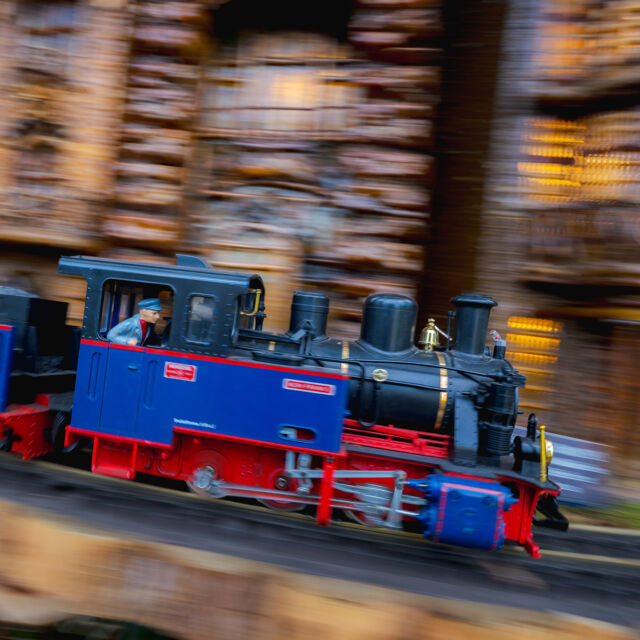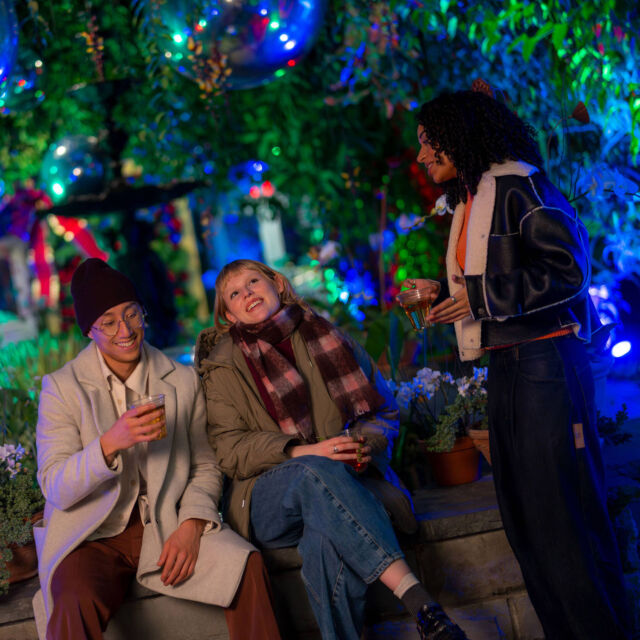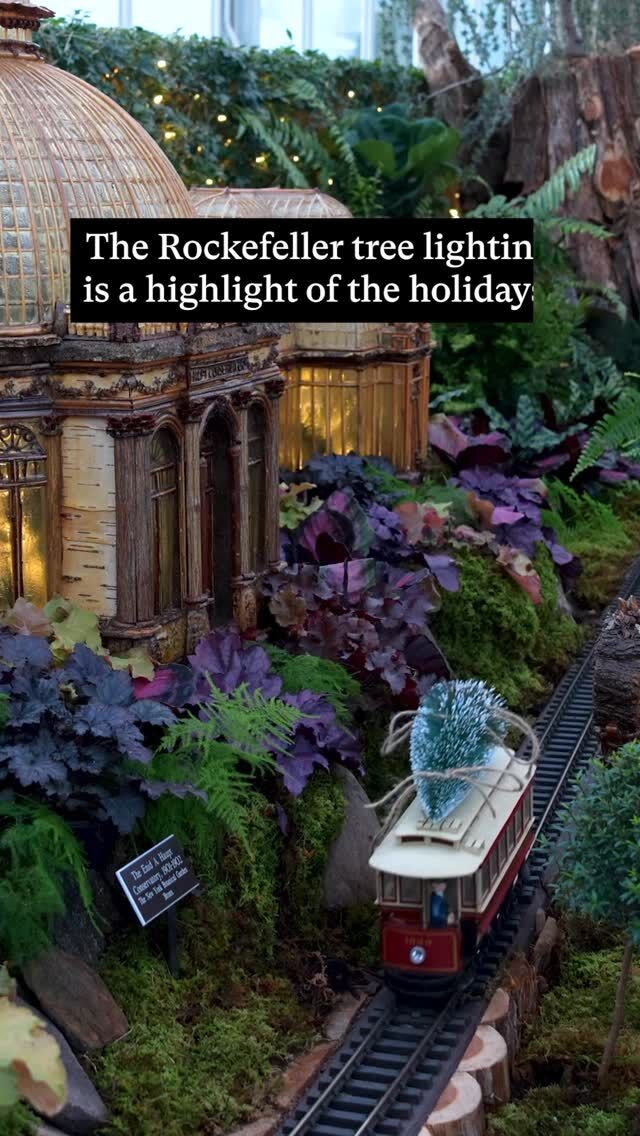Exchanging Perspectives from the Field
NYBG scientist, student, and local Panamanian trainee reflect on their experiences
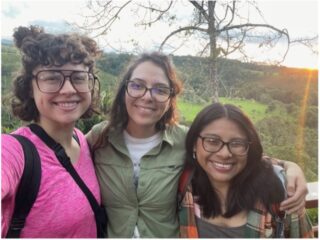
In January 2025, Kate Samra, a Ph.D. student at NYBG-CUNY; Diana García, B.S. student at Universidad de Panamá; and Ana María Bedoya, Ph.D., Assistant Curator at the Center for Biodiversity & Evolution at NYBG embarked on a field trip to the Caribbean coast of Panama. They engaged in EXTREME BOTANY, collecting plants alongside rivers and in river-rapids and waterfalls. Months after their trip—where they were joined by interns from the Smithsonian Tropical Research Institute, as well as local field assistants—they reflect on their experiences while in the field. The aim of this blog is to bring together their different perspectives and to show that during fieldwork, we may all be having different experiences; acknowledging and valuing the different perspectives of people at different career stages and backgrounds is a fundamental step toward more inclusive fieldwork. To that end, Diana, Kate, and Ana each wrote separate impressions on common topics they thought were most relevant from their trip. Their thoughts were later compiled in this blog. As a side note, Ana and Diana are native Spanish speakers and Diana chose to use her native language in this blog. A translation is provided throughout.
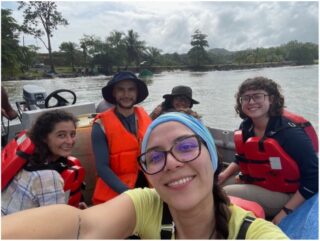
The trip started with a maritime boat ride to their first major collecting site. Limited road access to rivers in the region makes maritime transportation the primary (sometimes only) means of transportation to rivers in the region (Colón Province of Panama). What was the boat ride like for each of them?
Kate (K): The boat was long, skinny, and deep turquoise, with “Virgen del Carmen” painted on the side. Everything we had meticulously packed was secured under a tarp in the center: clothing, boots, food, water, ropes, bundles of newspaper, pole pruners, plant press, gallons of 70% alcohol, and countless other field supplies. We pushed off from the beach, and over the sound of the crashing waves and the revving engine, Ana looked at me and yelled, “Hold on!”
All of the sudden we were flying. The water was rough, and every few seconds the boat would jump six feet in the air before crashing back down to the surface. I heeded Ana’s advice and held on tight, bracing for each impact. I’ve always loved being on the water, so the start of this adventure, however painful, was perfect for me. I found myself uncontrollably smiling as we watched the town disappear and flew along the coast.
After about an hour, the boat slowed, and we began entering the mouth of a river. We pointed out bright orchids and ducked low-hanging lianas as our plant-minded brains began to tick. We docked the boat on the river’s edge, pulled on our knee high boots, and began the next leg of our journey on foot.
Ana (A): That was tough!!!!!! I was a bit worried mostly because I needed everyone to be safe. But it was also so beautiful. I vividly remember Kate’s face, as she was smiling quite a lot on both rides. So that felt good. It helped me relax a bit and enjoy the moment. The ride also made me think of the people of the towns on the rivers we were heading to and how isolated they are. Boat travel is the only means to leave the towns and seek medical care for instance, so it really made me think of sick people, pregnant women, older folks, infants, and how hard the circumstances are and how resilient humans are.
Diana (D): La navegación en lancha hacia la localidad de Diego fue una experiencia emocionante. El mar, el viento y las olas nos hicieron sentir la fuerza de la naturaleza en todo su esplendor. Observamos las islas, los manglares y las aves marinas. Los guías locales nos acompañaban en la aventura, compartiendo sus conocimientos sobre la flora, la fauna y la cultura de la región. Fue un momento de contemplación, de asombro y de profunda emoción.
Translation: The boat ride to Diego River was an exciting experience. The ocean, wind, and waves made us feel the strength of nature at its best. We observed islands, mangroves, and sea birds. Local field guides were joining us in the adventure, sharing their knowledge of the flora, fauna, and culture in the region. It was a moment to enjoy nature’s beauty.
The field trip’s main goal was to collect plants in the genera Tristicha and Marathrum (Podostemaceae), and Triolena (Melastomataceae). While on the first day of exploration the team found the former two, they had not yet found Triolena. Here is what Kate, Diana, and Ana experienced prior and after finally spotting individuals of Triolena in the field.
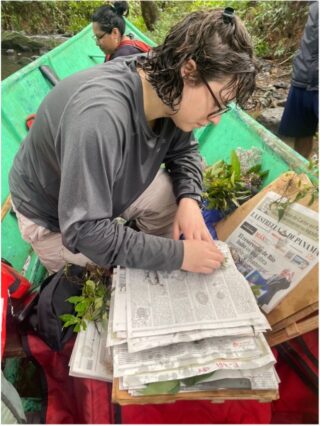
K: I have spent hours and hours studying herbarium specimens and images of Triolena, but coming into the trip, I had never seen these plants in the wild. In my limited Spanish, I explained to the team where to find the plants in and along rivers, how to recognize their opposite, unequal leaves, and how to identify their charismatic triangular fruits. Where words failed, I showed pictures and illustrations from .pdfs I had saved on my phone.
After an unsuccessful first day looking for Triolena, I set out the next day with cautious hope. For hours, Karen and Diana called out, “¿Triolena, dónde estás, Triolena?” in a hide-and-seek-like cadence as we lifted up branches and peered behind logs for the elusive plant. The encouragement and persistence of the team paid off. Towards the end of the day, as we were all anxious to change out of our perpetually wet clothes and eat dinner, we glanced along the river bank and squealed with delight as we spotted Triolena. It felt like a dream to finally see these plants in their natural habitat.
D: Nuestra misión seguía siendo colectar Triolena. Kate, con su conocimiento experto en el género y su pasión por las plantas, lideró la búsqueda. Revisamos cuidadosamente cada roca, tronco y orilla de los ríos que visitamos, siempre atentas a cualquier señal de la preciada Triolena. ¡Qué dicha fue encontrarla, allí en frente de nosotras!
Translation: We continued our mission aiming to collect Triolena. Kate is an expert in the group and very passionate about it, so she led the search. We carefully inspected each rock, fallen trunk, and the river surroundings, keeping our eyes out for it. It was so exciting to find it!
A: We had collected Podostemaceae but we had not found Triolena in flower and fruit just yet, so I was anxious to find it for Kate’s Ph.D. project. When Edilio, Jonathan (field assistants), and I saw the first fruits that Kate had described and shown to us in pictures, we got immensely happy. It was a huge relief and we started crafting plans to surprise Kate, who was collecting with Diana and other folks (that day we briefly separated to cover more ground in search for Triolena). Her excitement was priceless. I had the impression that sharing the joy of searching and finding the plant species they were looking for started bringing Kate and Diana closer. It is pretty awesome to think that all we had in common before meeting each other was our love for plants and excitement to engage in this expedition. To see how planning this whole thing brought people together and established new bonds was pretty rewarding.
While collecting plants was their main goal, the trip provided multiple opportunities for all participants to come together. One of the main challenges was the language barrier. This is how their interactions were perceived by each of them.
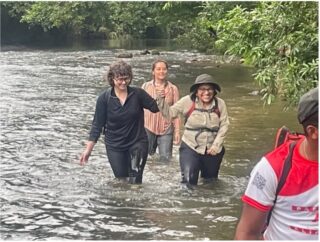
D: Kate y yo aprovechábamos cada momento libre para practicar nuestro español e inglés, los dos idiomas que nos permitirían comunicarnos, Intercambiábamos nombres de plantas en ambos idiomas, discutíamos sobre sus características, usos y compartíamos nuestros conocimientos sobre botánica. Gracias a Kate y Ana por enseñarme cosas nuevas.
Translation: Kate and I tried to take advantage of our free time to practice English and Spanish—the two languages in which communication could be possible between us. We exchanged plant names in both languages, discussed plant traits, uses, and shared botanical knowledge with each other. I am grateful to Kate and Ana for teaching me new things on this trip.
K: Diana would ask me a question in English, I would answer in Spanish. In turn, I would ask a follow up with a question in Spanish, and she would answer in English. We sometimes stumbled but always encouraged each other. We talked about our families, what food we liked, where we wanted to travel, what music we listened to, what classes we were taking next semester, and what plants we were interested in. Sometimes, we couldn’t find a translation and we would shrug it off, knowing that we would pick up the next day when we had the energy.
A: I think this was funny all around. Kate just saying yes to Diana. Diana going way too fast for anyone to comprehend. Both of them enjoying that interaction so much. Seeing them interact was a way of learning more about their personalities. The colorfulness of Diana’s personality and the kindness and assertiveness of Kate’s. They brought only positive things from each other.
Towards the end of the first part of the trip, the team made their way to a remote hidden waterfall that locals knew about. Everyone on the team agreed that this was one of the best collecting sites and fun places to have explored.
K: On this day, we decided to venture a bit further to a cascade that was supposedly covered in Triolena and Marathrum. We traversed pastures of cattle, icey cold rivers, steep waterfalls, mud up to our knees, and troops of curious monkeys. The challenging two-hour trek was well worth it when we arrived; Triolena and Marathrum were carpeting the cascade and the ground around it. After a successful few hours collecting specimens, we all swam under the waterfall and took turns jumping off rocks to celebrate the serendipitous end to our first leg of fieldwork.
D: Fuimos a un lugar donde, el día anterior, Ana y los demás habían visto muchas Triolenas y Marathrum. La caminata, aunque exigente, fue una experiencia inolvidable. Cada paso nos alejaba del ruido y nos sumergía más en el bosque. Nos dedicamos durante horas a colectar, trabajando en silencio, con concentración y asombro. Cada planta recogida parecía contar una historia distinta del ecosistema que la rodeaba. Fotografías, notas… Nuestras libretas se llenaban rápidamente. Una vez finalizado el trabajo, llegó el momento más esperado: nadamos bajo la cascada, gritamos, reímos, y saltamos desde las rocas. Compartimos frutas que llevábamos en las mochilas, nos secamos al sol sobre las piedras, y algunos incluso tomaron una siesta breve, arrullados por el sonido de la cascada. En ese instante, el cansancio se transformó en satisfacción, y la selva dejó de ser un escenario para convertirse en un hogar temporal. Aquel día no solo fue un logro científico; fue también una lección sobre la belleza del esfuerzo colectivo, la conexión con la naturaleza y el privilegio de poder observarla tan de cerca.
Translation: We went to a place where, the day before, Ana and the others had seen many Triolenas and Marathrum. The hike, though demanding, was an unforgettable experience. With each step, we left the noise behind and became more immersed in the forest. We spent hours collecting plants, working in silence, with focus and awe. Each specimen seemed to tell a different story about the ecosystem around it. Photographs, notes… our notebooks quickly filled up. Once we finished collecting plants and taking notes, the most anticipated moment arrived: we swam beneath the waterfall, laughed, and jumped off the rocks. We shared fruit from our backpacks, dried off in the sun on the stones, and some of us even took a short nap, lulled by the sound of the cascade. In that moment, fatigue turned into satisfaction, and the jungle ceased to be just a setting—it became a temporary home. That day wasn’t just a scientific achievement; it was also a lesson on the beauty of collective effort, connection with nature, and the privilege of observing it so closely.
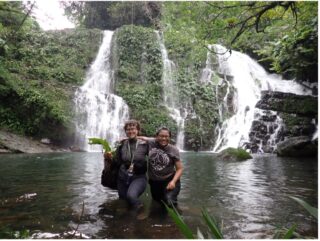
A:The place was paradise! I had been there the day before with other members of the trip and we all started jumping and laughing at how perfect it was, not only for its beauty but because it was covered in Marathrum foeniculaceum and Triolena. We had to leave without collecting because one member of the crew got stung by a scorpion! I recognized it was not a poisonous one, but decided to head back after providing first aid. The following day we all went back to sample. It was so cool for me to feel like the place was making everyone happy. Not only did we collect lots and fulfill our botanical hearts—this hidden waterfall was a bonding place for the team members who jumped in the water and played around. For me, a waterfall full of Marathrum was so productive and fun, and knowing Kate was also collecting alongside Diana was great too.
Diana’s fascination for the natural world contributed greatly to the team. Her upbeat personality was so uplifting that we reflected on it.
D: Me fascinó encontrar insectos en las rocas junto a Tristicha y Marathrum, observaba cómo estos pequeños seres interactuaban con su entorno, ¡La naturaleza es tan compleja y bonita! Nos interesa estudiar la relación entre las plantas y los insectos, ya que estas especies de plantas pueden depender de los insectos para su polinización. Documentamos cada detalle con fotografías, videos y muestras. A pesar de su belleza, singularidad e importancia, la familia Podostemaceae a menudo pasan desapercibidas y no reciben la atención que merecen. Se necesita más investigación para comprender su diversidad, distribución y ecología. Además, muchas de estas plantas se encuentran amenazadas por la contaminación, la deforestación y otras actividades humanas. Deseo que este hallazgo sea un valioso aporte para la ciencia y tenga un impacto positivo en la investigación y el trabajo de la Dra. Ana.
Translation: I was fascinated to find insects on the rocks alongside Tristicha and Marathrum. I watched how these tiny creatures interacted with their environment—nature is so complex and beautiful! We’re interested in studying the relationship between plants and insects, as these plant species may depend on insects for pollination. We documented every detail with photographs, videos, and samples. Despite their beauty, uniqueness, and importance, the Podostemaceae family often goes unnoticed and doesn’t receive the attention it deserves. More research is needed to understand their diversity, distribution, and ecology. Moreover, many of these plants are threatened by pollution, deforestation, and other human activities. I hope this discovery becomes a valuable contribution to science and has a positive impact on Dr. Ana’s research and work.
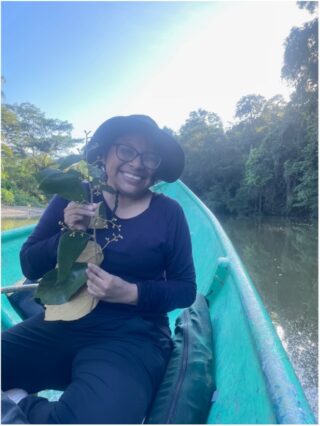
K: It’s a really neat feeling to see someone experience discovery and wonder. Especially if that someone is your friend, and especially especially if she is looking at plants! Diana’s excitement about Marathrum pollinators was contagious.
A:This was very fun and truly an inspiring moment. Seeing how the thought of a discovery made Diana so excited. Her eyes lit up and she seemed so proud of herself for having observed something that she thought of value. Her push for that to be properly recorded was energizing and I am looking forward to her taking those observations further!
While field exploration is full of adventures and valuable scientific observations and discoveries, the success of a field expedition requires thorough planning of field locations and safety measures. Diana, Kate, and Ana reflected on expectations and fears and how they changed before and after the trip to Panama. Note that while Diana is Panamanian, she had not been in any of the localities visited in her home country.
K: Since I was young, it’s been my dream to travel to new places and study plants. So, when I was invited on this trip, I was ecstatic to share with my friends and family the news of my upcoming adventure. I should not have been surprised, however, when I did not always receive an equivalent level of excitement in return. The responses ranged from: “Wow… why…?” “Are you going alone?” “Is your boyfriend going with you?” “Is Panama safe?”, and “That’s something you want to do?” These questions were usually accompanied by looks of trepidation. I won’t lie and say there weren’t some self-imposed nerves too. Despite my appetite for adventure, I can be a pretty anxious person.
It is difficult not to internalize other people’s uncertainty of you. As a woman in STEM, this is often a daily battle. For me, the most difficult part of the trip, and the time leading up to the trip, was challenging the seeds of doubt that myself and others planted. But I know that it’s exactly experiences like this that remind me that I’m stronger than I think I am.
D: La emoción y los nervios se mezclaban en el ambiente antes de nuestra tan esperada salida de campo. Ana y Kate como botánicas apasionadas, habían estado planeando este viaje durante meses, la emoción crecía a medida que se acercaba la fecha. Me imaginaba explorando paisajes hermosos, descubriendo especies de plantas fascinantes que nunca había visto, sumergiéndome en la rica biodiversidad de Panamá. Sin embargo, como suele suceder con cualquier aventura, mis expectativas también venían acompañados de ciertas dudas y miedos. ¿Sería capaz de identificar correctamente todas las plantas que encontráramos en nuestro camino? ¿Qué desafíos nos enfrentaríamos al estudiar la flora local, desde las condiciones climáticas hasta la interacción con las comunidades locales? ¿Y si descubríamos una nueva especie de planta, cómo la clasificaríamos y documentaríamos? A pesar de estos miedos, la curiosidad y el deseo de aventura eran mucho más fuertes rindieron frutos ya que aprendí especies de plantas que no conocía.
Translation: Excitement and nerves filled the air before our long-awaited field trip. Ana and Kate, both passionate botanists, had been planning this journey for months, and the anticipation grew as the date approached. I imagined myself exploring beautiful landscapes, discovering fascinating plant species I had never seen before, and immersing myself in Panama’s rich biodiversity.
However, as often happens with any adventure, my expectations were also accompanied by certain doubts and fears. Would I be able to correctly identify all the plants we encountered along the way? What challenges would we face while studying the local flora—from weather conditions to interactions with local communities? And if we discovered a new plant species, how would we classify and document it? Despite these fears, my curiosity and desire for adventure were much stronger and I think all the effort payed off as I learned new plants on this trip.
A: For me preparation for the trip was all about safety. I usually feel the nervousness of anticipation, of hoping that I find what we went for; that I chose the localities that help me reach the goals I set to accomplish. This time I was focused on the safety of others as well. I put a lot of work into thinking about what was important: To be ready to change plans; to always be observant of our surroundings; to always be ready to make important decisions and to do that effectively; to observe and try to identify how people were feeling; to listen to the team while being ready to make decisions that wouldn’t make them happy. To give them as much info as possible and to communicate changes to our plans effectively. To give people space to have some alone moments, to keep people’s energy up without being too intense. In other words, to give people a great learning and field work experience while keeping them all very safe.
I am not from Panama, so not having been in many of the places we went to beforehand meant that to secure the success of the trip, I had to carefully choose the best people to join and whom I could fully trust. I was joined by incredible people, from collaborators to local field guides and students from Panama, Colombia, and the US. Edilio, the local guide that supported me so much with logistics; my collaborator Caros Jaramillo; and Karen Cárdenas at STRI provided all the conditions for this trip to run smoothly. I was just surrounded by students who wanted to learn and observe so much. I was not anticipating the level of commitment, engagement, and energy of all members involved. I am so thankful for the people that joined me. I am very much looking forward to seeing them develop their projects and careers.
Women were historically excluded from field expeditions. To this day, the experiences of female scientists during fieldwork vary greatly from those of their male counterparts. From harassment to personal hygiene, and physical demands, to the undermining of their expertise, female scientists continue to experience challenges during field exploration. Diana, Kate, and Ana reflected on their experiences as women at various stages of their career.
K: There are countless ways in which women experience fieldwork differently: people doubting your strength and ability, being interrupted and spoken over, the glaring burn of the male gaze, and the constant and heightened awareness of your safety, to name just a few. While acknowledging these unfortunate realities, and also understanding that my experience often differs as a white woman, I want to focus on what I can only describe as the absolute and unmatched magic of women doing fieldwork.
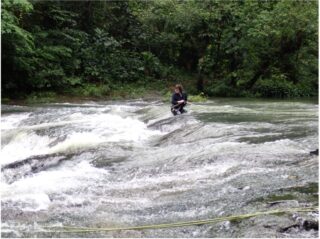
Picture: Ana skillfully leading a 10-person team through the jungle, Diana bravely repelling down a waterfall to collect Podostemaceae, Karen expertly hauling equipment above her head in chin-deep rapids, and Kate carefully maneuvering 20-foot-long pole clippers to collect a flower in the canopy. When you’re told you can’t do something, both directly and indirectly, the feeling of doing that something, and watching other women do it too, is one of outright joy. It is the actualization of something that you’ve been told is not possible, but that you’ve always known is true: that you can be, discover, experience, and accomplish anything. Sharing that joy with Ana, Diana, and Karen is something that I will carry with me forever.
D: La salida de campo en Panamá fue una experiencia profundamente enriquecedora, tanto a nivel personal como profesional. Pude aplicar mis conocimientos, fortalecer habilidades prácticas y trabajar en equipo de manera colaborativa y eficiente. El entorno natural y los desafíos del terreno me permitieron desarrollar una mayor capacidad de adaptación y resiliencia. Aprendí a observar con mayor detalle, a registrar información valiosa en tiempo real y a tomar decisiones con criterio técnico en situaciones cambiantes. Además, esta experiencia fortaleció los lazos con mis compañeros de equipo, fomentando la comunicación, el respeto y el apoyo mutuo. Compartimos aprendizajes, superamos obstáculos juntos y celebramos los logros del grupo. Sin embargo, también enfrenté desafíos particulares por ser mujer. En varias ocasiones tuve que esforzarme más para que mis ideas fueran escuchadas o tomadas en cuenta por mis colegas hombres, o para demostrar que era tan capaz como mis colegas hombres.
Aunque puedan parecer pequeños o “inofensivos”, algunos comentarios afectan. Minan la confianza y la autoestima, y hacen sentir que el valor de una no se basa en sus capacidades, sino en su género. Por suerte, conté con el apoyo y la solidaridad de mis compañeras, lo cual fue clave para mantenerme firme y motivada. A pesar de todo, no permití que estos obstáculos me detuvieran. Como mujer y como científica, estoy orgullosa de lo que logré en esta experiencia y sigo comprometida con luchar por la igualdad de género en la ciencia y en todos los ámbitos de la vida. Me siento orgullosa del trabajo realizado, del crecimiento profesional que esta experiencia me brindó y del compromiso demostrado por todo el equipo. Sin duda, esta salida de campo fue una oportunidad única para seguir creciendo en el ámbito de la investigación y reafirmar mi pasión por la botánica.
Translation: The field trip in Panama was an incredibly enriching experience, both personally and professionally. I was able to apply my knowledge, strengthen practical skills, and work collaboratively and efficiently as part of a team. The natural environment and the challenges of the terrain helped me develop greater adaptability and resilience. I learned to observe more closely, record valuable information in real time, and make sound technical decisions in changing situations. This experience also deepened the bonds with my teammates, fostering communication, mutual respect, and support. We shared lessons, overcame obstacles together, and celebrated our collective achievements. However, I also faced particular challenges as a woman. On several occasions, I had to work harder to have my ideas heard or considered by male colleagues, or to prove that I was just as capable as they were. Though they may seem minor or “harmless,” certain comments can be hurtful. They chip away at confidence and self-esteem, making it feel as though your value lies in your gender rather than your abilities. Fortunately, I had the support and solidarity of my female colleagues, which were key to staying strong and motivated.
Despite everything, I did not let these obstacles stop me. As a woman and a scientist, I am proud of what I accomplished during this experience, and I remain committed to fighting for gender equality in science and in all areas of life. I am proud of the work we did, the professional growth this experience offered me, and the commitment shown by the entire team. Without a doubt, this field trip was a unique opportunity to continue growing in research and to reaffirm my passion for botany.
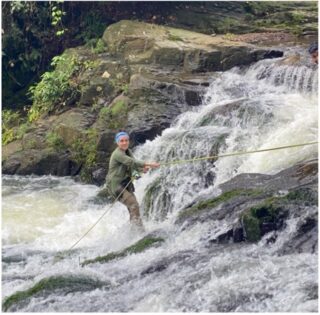
A: I think I learn more and more about how to separate events of gender-based discrimination and microaggression from my individual experience, so they don’t touch me personally. It takes a bunch of self-affirmation, to genuinely not care about others minimizing you while believing in you. I have found that to be a strategy that keeps me calm and helps me handle situations better. It is not that I adjust and accept the unfortunate situations that women go through in the field. I don’t. The way I would put it is that what works for me is to avoid losing my marbles so I can be in full control of the situation. This time I had the added responsibility that I was to be a figure of leadership in support of the female students on the team, so actions would have to be taken to directly and promptly address any misconduct. I strived to find the best people I could to join me on this trip, and I ended up with a team where the only trained botanists were female. Creating a space where women in the team felt like they had the tools and felt comfortable reporting misconduct was key, not only because it is the most humane thing to do, but also because this would allow us to focus instead on the plants and research, which are what brought us on the expedition. While we had a trip where we accomplished all of our research goals, we still had to deal with gender-based discrimination. One thing I love about science is that when someone makes a discovery, finds something incredible, suddenly we all listen and are captivated by their message; we transcend whatever differences we may have and look at what is in the mind. Going back to my main point, I don’t have time to teach people that women know how to put on their field boots; I would rather spend that time attempting to captivate audiences through cool plant research.
SUBSCRIBE
Enter your email address to subscribe to this blog and receive updates on new posts.






